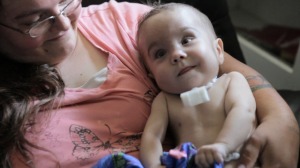by
Carol Ko, Staff Writer | May 28, 2013

April Gionfriddo
holds her son Kaiba in 2012
Courtesy of the University of Michigan
Health System.
Three-month old Kaiba Gionfriddo was in very grave condition by the time his doctors reached out to associate professor of pediatric otolaryngology, Dr. Glenn Green, at the University of Michigan.
Kaiba suffered from a severe case of tracheobronchomalacia, a rare condition in which the airways collapse during breathing and coughing.
Several interventions had already been tried on him including being placed on a ventilator, surgery, and daily oxygenation. Even so, his collapsed bronchus made it difficult for him to breathe, and his prognosis for leaving the hospital alive was grim.



Ad Statistics
Times Displayed: 333
Times Visited: 2 Keep biomedical devices ready to go, so care teams can be ready to care for patients. GE HealthCare’s ReadySee™ helps overcome frustrations due to lack of network and device visibility, manual troubleshooting, and downtime.
Enter Dr. Glenn Green and Dr. Scott Hollister, professor of biomedical engineering and mechanical engineering and associate professor of surgery at University of Michigan. They sprang into action and obtained emergency clearance from the U.S. Food and Drug Administration to create and implant a splint made from a biopolymer material.
Prior to this case, Green and Hollister had already been testing airway splints and were moving toward an eventual trial, asking colleagues to put them in contact with patients who may be good candidates. But their plans changed when a colleague called from Ohio. "He said, hey, I know you're not ready for a trial but I got a kid that needs it now," Green told DOTmed News.
The child was brought to the university, and Green and Hollister created a customized airway splint for Kaiba within 48 hours of giving him a CAT scan.
Over a year later, Kaiba has been taken off the ventilator and has not had trouble breathing since. "It worked better than I'd ever hoped for," said Green.
In the review of the case, published in the New England Journal of Medicine, the authors noted that because the device eliminated the need for ventilators, Kaiba's cost of care was one-third that of less severe patients, lowered by hundreds of thousands of dollars.
Green hopes to replicate the device's success with Kaiba in other patients. "Our plan is to demonstrate it works in severe cases, and then we can consider interventions in regular cases as well," he said.
3-D printing has opened up new avenues for surgeons hoping to create medical devices with a fine level of customized detail. Unlike older manufacturing processes like injection molding, it enables rapid manufacture of small numbers of parts.
"3-D printing really allows fine structures to be put in place that you can't get by hand, so true engineering can be applied to it," said Green.

